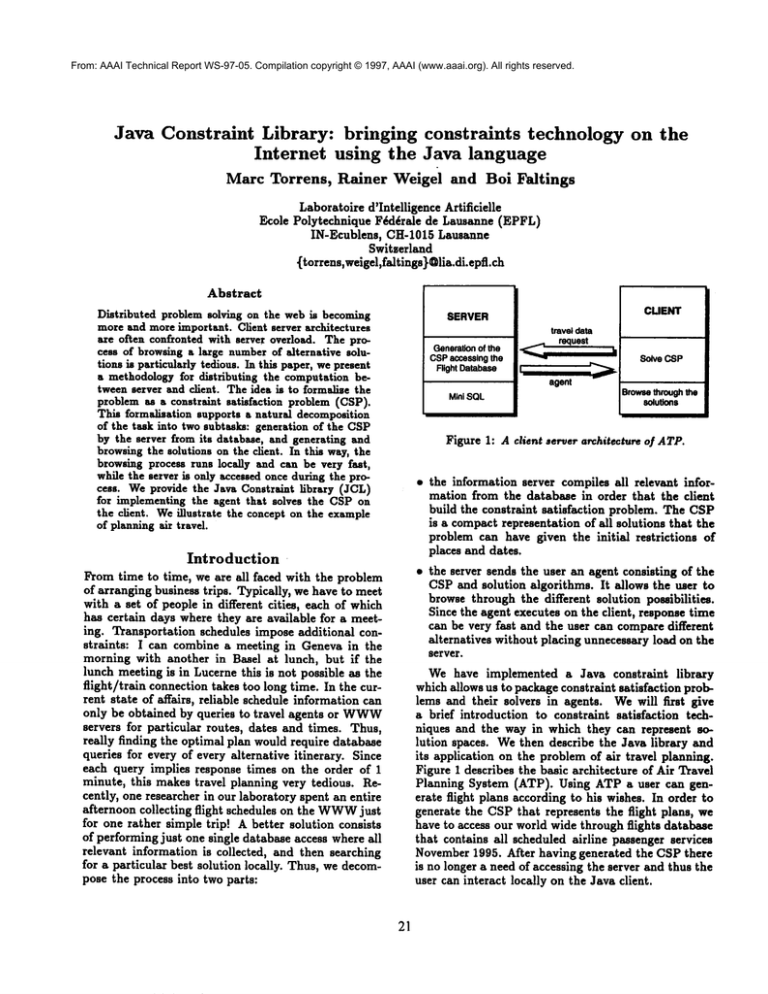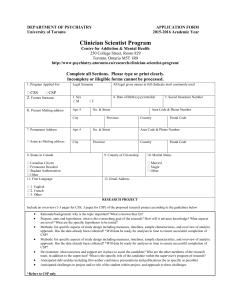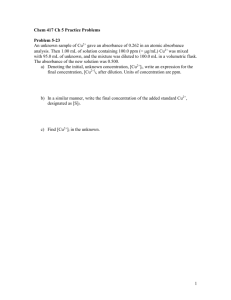
From: AAAI Technical Report WS-97-05. Compilation copyright © 1997, AAAI (www.aaai.org). All rights reserved.
Java Constraint
Library: bringing constraints technology
Internet using the Java language
Marc Torrens,
Rainer
Weigel
on the
and Boi Faltings
Laboratoire d’Intelligence Artificielle
Ecole Polytechnique
Fbi~rale de Lausanne (EPFL)
IN-Ecublens,
CH-1015 Lausanne
Switserland
{torrens,weigel,faltings}@lia.di.epfl.ch
Abstract
Distributed problem solving on the web is becoming
more and more important. Client server architectures
are often confronted with server overload. The process of browsing a large number of alternative solutions is particularly tedious. In this paper, we present
s methodology for distributing
the computation between server and client. The ides is to formalise the
problem as s constraint satisfaction
problem (CSP).
This formalisation supports a natural decomposition
of the task into two subtasks: generation of the CSP
by the server from its database, and generating and
browsing the solutions on the client. In this way, the
browsing process runs locally and can be very fast,
while the server is only accessed once during the pro.
ceas. We provide the :lava Constraint library (JCL)
for implementing the agent that solves the CSP on
the client. We illustrate
the concept on the example
of planning a~ travel.
CLIENT
SERVER
Generation
of the
CSP
accessing
the
FlightDatabase
traveldata
request
SolveCSP
%
agent
Mini SQL
b
Browse
through
the
solutions
Figure 1: A client server architecture
o~ ATP.
¯ the information server compiles all relevant information from the database in order that the client
build the constraint
satisfaction
problem. The CSP
is a compact representation
of all solutions that the
problem can have given the initial
restrictions
of
places and dates.
Introduction
From time to time, we are all faced with the problem
of arranging business trips. Typically, we have to meet
with a set of people in different cities,
each of which
has certain days where they are available for a meeting. Transportation
schedules impose additional
constraints:
I can combine a meeting in Geneva in the
morning with another in Basel at lunch, but if the
lunch meeting is in Lucerne this is not possible as the
flight/train
connection takes too long time. In the current state of affairs,
reliable schedule information can
only be obtained by queries to travel agents or WWW
servers for particular
routes, dates and times. Thus,
really finding the optimal plan would require database
queries for every of every alternative
itinerary.
Since
each query implies response times on the order of 1
minute, this makes travel planning very tedious. Recently, one researcher in our laboratory spent an entire
afternoon collecting
flight schedules on the WWW
just
for one rather simple trip! A better solution consists
of performing just one single database access where all
relevant information is collected,
and then searching
for a particular
best solution locally. Thus, we decompose the process into two parts:
2]
¯ the server sends the user an agent consisting of the
CSP and solution algorithms. It allows the user to
browse through the different solution possibilities.
Since the agent executes on the client, response time
can be very fast and the user can compare different
alternatives
without placing unnecessary load on the
server.
We have implemented a Java constraint
library
which allows us to package constraint satisfaction
problems and their solvers in agents. We will first give
a brief introduction
to constraint
satisfaction
techniques and the way in which they can represent
solution spaces. We then describe the Java library and
its application on the problem of air travel planning.
Figure 1 describes the basic architecture
of Air Travel
Planning System (ATP). Using ATP a user can generate flight plans according to his wishes. In order to
generate the CSP that represents the flight plans, we
have to access our world wide through flights database
that contains all scheduled airline passenger services
November 1995. After having generated the CSP there
is no longer a need of accessing the server and thus the
user can interact locally on the Java client.
Shell
user-friendlyinterface for editing andsolving
CSPs
JCL
JavaScript
algorithmsfor searching
solutions and preprocessing
CSPs
Figure 3: The constraints editor in the Constraint She~.
functionsfor
scripting HTML
pages
Search Algorithms
In JCL we have implemented 13 algorithms adapted
from (van Beck ). There are three main algorithms derived from Chronological Backtracking (BT) that ace:
Backmarking (BM), Backjumping (BJ) and Forward
Checking (FC) (Tsang 1993). Some combinations
them are implemented in (van Beck ) and adapted’in
JCL. FC, for example, performs the consistency checks
forward. At each level, the domainsof the future variables are filtered in such a way that all values inconsistent with the current instantiation are removed. FC
is very efficient because of its ability to discover inconsistencies early. The size of the backtrack tree is reduced. However, FC sometimes performs more consistency checks than backward algorithms. In (Kondrak
1994) there are the hierarchies of some algorithms with
respect to the number of visited nodes in the search
tree and with respect to the consistency checks.
JAVA language
Figure 2: The components o/ the JCL environment.
Constraint
Satisfaction
JCL
Problems and
Manyimportant applications, such as configuration,
resource allocation and diagnosis can be modeled as
discrete Constraint Satisfaction Problems (CSPs).
CSP is defined
by P = (X,D,C,R),
where X =
{X1,...,Xn} is a set of variables, D = {D1,...,D~}
a set of finite domains associated with the variables,
C = {C1,..., C,~} a set of constraints, and R ={R~j C
Di x Dj for a constraint applicable to Xi and Xj } a
set of relations that define the constraints. Solving a
discrete CSPamounts to finding value assignments to
variables subject to constraints. The theoretical complexity for solving CSPs was shown to be exponential, however for manyreal world applications the corresponding CSP can be transformed in a reasonable
amount of time into a CSPthat can be solved in linear
time. A large body of techniques exists for efficiently
solving CSPs.
JCL is a Java library that can be used in a Java
enabled browser (applet) and in stand-alone Java applications. Figure 2 shows the components of the JCL
environment. Its purpose is to provide the building
blocks for agents that solve binary Constraint Satisfaction Problems (CSPs). JCL is divided into two parts:
A basic constraint library available on the network and
a constraint shell build on top of this library, allowing
CSPs to be opened, saved, edited and solved. JCL
allows the development of portable applications and
applets using the constraint mechanisms.
Algorithms
The library
rithms.
Preprocessing
Algorithms
The objective of the preprocessing is to reduce the sise
of the CSP by removing redundant values from the
domains of the variables, or by removing redundant
compoundlabels from the constraints.
A value of a
variable is redundant whenits removal does not affect
the solutions of the CSP. If all the values from the domain of a variable are removed, then the CSPis insoluble. In JCL we have implemented two preprocessing
algorithms adapted from (van Beek ) : Arc-consistency
and Path-consistency.
The Constraint
Shell
The purpose of the shell is to provide a user-friendly
interface to the library. The following aspects are taken
into consideration:
¯ CSPproblems definition
¯ algorithms application,
and generation,
¯ intermediate and final solution management.
Figure 3 shows how constraints in between variables
can be edited using mouse and menus.
Another important window is the "solving control"
windowshownin figure 4. It lets the user choose the
algorithm, solution options, displaying options, and
in JCL
contains search and preprocessing algo-
22
Accessing
start the algorithm. The solutions and the displaying options panel selects the different options for solution output. The HTMLoutput produces output in a
browser window. The "Algorithm" panel permits algorithm selection between the JCL algorithms or other
algorithms implemented by the user. While the algorithm is working, a "Solving in progress" window
is displayed by the default solution manager, indicating among other things how many solutions have been
found until now, and allowing to suspend, resume or
stop the resolution. JCL is available from the Internet
at: http://liawww.epfl.ch/torrens
Problem
server
architecture
for
Formulation
The input data for ATPsystem is a set of meetings,
where every meeting is described by the place and the
possible time-slots for the different days the meeting
can take place. A solution of the business travel problem can be seen aa a sequence of flights in between the
cities of the meetings. For each meeting one of the possible days must be assigned and it must be guaranteed
that then exists at least one flight connection between
consecutive meetings. Wehave formulated the problem of finding a travel plan aa a binary constraint satisfaction problem (CSP). The variables of the travel plan
CSP is the union of meeting variables MVand flight
variables FV. The meeting variables together with the
constraints between them induce a constraint problem
that we call meeting CSP (MCSP). Similarly the CSP
induced by the flight variables FVis called flight CSP
(FCSP). Next we describe the MCSP, the FCSP and
the constraints between them in more detail.
Travel
The prototypical business Air Travel Planning (ATP)
system is designed to illustrate the use of JCL for planning. A air travel plan is a sequence of flights connecting different cities a user wants to visit. Given
such a set of cities together with possible time slots to
visit each city, the system generates a representation
of plans from which the user can easily select the most
preferred one. Before describing the details and an example we will first present the architecture of ATP.
A client
database
In order to access to the flight data needed to build
1.
the CSP, we have created a database using MiniSQL
Weuse a Java class library called MsqlJava3 which
allows applications or applets to access and manipulate
MiniSQLdatabases. In the server the MiniSQLserver
is running in background, and thus is possible that the
applet client can access to the flight database in order
to build the CSP. Table 1 describes some rows of the
created database.
Figure 4: The solving control tvindow.
Prototypical
business
Air
Planning
system
to the server
Meeting CSP (MCSP) For every meeting Mi
variable Mgi(i = 1,..., n) is created and the domain
of the variable is the set of possible days where the
meeting M~ can take place. There is an inequality
constraint between two variables if their domains intersect in at least one value. A solution of the MCSP
is a assignment of day to each meeting such that no
two meetings can be held on the same day. Having a
solution does of course not guarantee that the solution
can be refined downto the actual flights. Consider as
example the travel data from table 2. Solving MCSPis
computational equivalent with solving the list coloring
problem which is known to be NP-complete.
ATP
The basic idea is that a client sends a request containing the users raw travel data to a server. The server
will have access the flight database in order to generate
a Constraint Problem whose solutions are the possible
travel plans that will satisfy to the users requests. This
CSPtogether is packaged with search algorithms from
the JCL to form an agent which can interact with the
user. Building the CSPrequires only a small fraction
of time compared to solving the CSP, so having the
agent execute on the client significantly reduces server
load.
XReferenceat http://Huges.com.au
2Reference at http://mama.minet.uq.os.au/msqljava
23
[ M[
M1
M2
M3
M4
M5
M6
M7
City [
AMS
BCN
LON
GVA
PAR
BER
FRA
Meeting First Solution
M1
1" 12h-16h
1’¢ 12h-15h
M2
M3
2n~ 12h-15h
M4
2nd 9h-12h
M5
5" 8h-12h
M6
6’~ lSh-18h
M7
4th 8h-12h
Time-Slots for November
1" 12h-16h 3¢~ 13h-15h
1" 12h-15h 2"~ 13h-17h
2~d 12h-15h 8th llh-14h
2~d 9h-12h 4t~ 9h-12h
5’h 10h-15h
5m 8h-12h 8¢’* 8h-12h
6t~ 15h-18h 8t~ lOh-16h
4th 8h-12h
7~h 8h-12h
Second Solution
3¢~ 13h-15h
2"~ 13h-17h
8m llh-14h
4ta 9ho12h
8" 8h-12h
8m lOh-16h
7*~’ 8h-12h
Table2:InputDatato besendtotheserver.
Table 3: T~#oof the possible solutions to the MGSP.
Flight CSP (FCSP) The FCSP can be considered
as theplanning
or sequencing
partof thetravel
planningCSP.Foreachplanning
stepexistsa variable
and
thevalues
oftheseplanning
stepsaretheflights
in betweencitieswherethemeetings
couldtakeplace.In
orderto applya flightaction
frommeeting
j to meetingi is thetraveler
mustsimplyhavefinished
meetingj andhe should
arrivebefore
themeeting
i starts.
Whenever
a meetingis scheduled
for day/cwe create
a "BeforeMeeting"
variableBMh and a "AfterMeeting"variable
AMk.Usingsucha modelletsus easily
express
theconstraint
thata traveler
wouldliketostay
in townX afterthemeeting
andtakestheflight
on the
nextday.Thevalues
fora B]VIivariable
areeither
the
flightfroma meeting
he hadbeforedayi to thepossiblemeeting
places
at day/c(/c~ i)arriving
before
the
meeting
startsor a "no-action"
valueif he is already
in a citywherethemeeting
takesplace.
in theFCSP.Theallowedvaluecombinations
are the
following:
¯ [M~-BMk]: I~ is compatible with a "flight to cry of
meeting k" or with the "no-action" if we are already
in the city of meeting/~. All the other values of M~
are not related with the meetings on day k and are
therefor valid.
¯ [M~ - AMh]:similar to the other constraints above.
is compatible with a "flight from city of meeting
k to another city" or with the no-action if we are
planning to stay overnight in the city of meeting k.
All the other values of Mi are not related with the
meetings on day k and are therefor valid.
Example
Weuse the example already presented in table 2. The
user will in a first step decide on the days the meeting can take place. That is he decides on the days the
meetings will take place without having to consider
Constraints
Havingintroduced the variables and
more details. For doing so the system needs to solve
the valuesfor the MCSPand FCSP we will now dethe MCSP(see table 3). A solution to the MCSP
scribetheconstraints
thathaveto be satisfied.
The
a partial solution of the overall CSPwhich can then
following
constraints
needto be expressed:
be propagated to the FCSP. This allows the removal
¯ [AM~- BMk+x]:if we stay at the meeting place on
of values from the domains of the variables in FCSP
day k, which is the "no-action" value AMk,then we
that are not consistent with selected days by the users.
have to fly to the place of meeting /~ + 1 arriving
One can show theoretically
that making the CSP arcbefore the meeting starts. On the other hand, the
consistent after having decided on the meeting days
flight to the meeting ]~ % 1 leaving the meeting city/~
guarantees global consistency of the CSP. This implies
after the meeting, is compatible with the "no-action"
that any partial solution of the FCSPcan be extended
value for Bk+x.
to a global solution of the whole CSPwithout backtracking. The table 4 describes the variables and their
¯ [BMk - AMk]: four combinations are possible : 1)
domains of FCSPafter having propagated the second
The "flight-flightn tuple, if we arrive in the city dipartial solution from table 3. In table 4 one can observe
rectly before the meeting and leave the city on the
for examplethat there are no flights leaving Barcelona
same day. 2) The "no-action-flight" tuple if we are
with destination Amsterdam after 17h. This implies
already in the city and leave directly after the meetthat the user has to fly to Amsterdam the next day.
ing. 3) Similarly the"flight-no-action"
andfinally
Furthermore no hotel is needed in Amsterdamsince he
4) the"no-actionno-action"
tuple.
is required to take the flight to Genevadirectly after
To describehow decisionsmadein the MCSP can
the meeting. The user can select a single flight from
be propagated
to the FCSP,we haveto describe
the
all flights leaving Barcelona and arriving in Amsterconstraints
in betweenMCSPand FCSP:If a variable
dambefore 13h depicted in table 5. The actual flights
can then be presented to the user in the form of a list
M~ has thevalue/c
in itsdomaini.e.meeting
Mi can
bescheduled
onthekthday,thenthereis a constraint such that the user can easily select the most preferred
in betweenthe BMk variableand the AMt variable
one.
24
Meeting
1. M2
2. M1
3. M4
4. M5
5. M6
6. M7
7. M3
City ] DayI TimeSlots
BCN 2~d
13h-17h
3ttt
AMS
13h-15h
GVA 4th
9h-12h
th
5
PAR
8h-12h
th
BER 6
15h-lab
|A
7
FRA
8h-12h
Ch
8
LON
llh-14h
Variable BM
FL : M0- M2
FL : M2- M1
M4
M5
M6, FL : MS- M6
M7
M3, FL : MT- M3
Variable AM
M2
FL : M1 - M4
FL : M4- M5
M5, FL : MS- M6
FL : M6 - M7
MT, FL : M7- M3
M3
Table 4: The solution space after hauingpropagateda partial solution.
I Comp ] Fly ]From [ To I
IB 4248 BCN AMS 10:15
KL 352 BCN ]AMS 7:05
SR
724 GVA PAR
AF
2855 GVA PAR
SR
726 GVA PAR
AF
2835 GVA PAR
AF
2893 GVA PAR
SR
728 GVA
PAR
AF
2887 GVA
PAR
Dep [ Art [ Dur ]
] 12:25 ] 2:10 [
[ 9:25 2:20 ]
12:15 13:20 1:05
14:10 15:15 1:05
16:15 17:20 1:05
17:15 18:20 1:05
18:05 19:10 1:05
18:45 19:50 1:05
20:40 21:45 1:05
Table 5: Possible flights arriving in Amsterdam from
Barcelonabefore 13h. and the flights from Genevato Paris
on the 4ts day.
Conclusion
As a result of the spread of the world-wide web, interactive information servers axe becoming more and more
important. Browsing through databases requires quick
response times which are difficult to achieve whenusers
interact directly with a server. Wehave shown an example of how the agent techniques underlying Java can
separate browsing from database access. The key element of this approach is to represent solution spaces
through constraint satisfaction
problems. The same
approach is applicable to other problems where a combination of elements needs to be configured into a coherent whole. Such configuration systems will be an
important technology for manyareas of electronic commerce.
References
Kondrak, G. 1994. A Theoretical Evaluation of Selected Backtracking Algorithms. Technical Report
TR-94-10, Department of Computing Science, University of Alberta, Edmonton, Alberta, Canada.
Tsang, E. 1993. Foundations of Constraint Satisfaction. London, UK: Academic Press.
van Beek, P. CSPI, ib : a CSPlibrary written in C language, vanbeekOcs.ualberta: University of Alberta.
25


